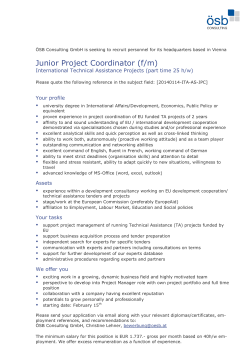
Raman spectroscopy as novel marker for sensitive
DECHEMA 2015 ATMP 2015 - Issues and challenges from bench to bedside Raman spectroscopy as novel marker for sensitive stem cell identification Schütze, K., CellTool GmbH, Bernried, Germany; Marino D., Tissue Biology Research Unit, Department of Surgery, University Children`s Hospital, Zürich, Switzerland; Meyer S., Tissue Biology Research Unit, Department of Surgery, University Children`s Hospital, Zürich, Switzerland Introduction Raman spectroscopy (RS) is a highly sensitive analytical method for marker-free and noninvasive identification and characterization of cells. We demonstrate feasibility of RS in 3dimensional setups such as differentiated Human Gingival Fibroblasts cultured within collagen matrices (mucoderm®) and autologous dermo-epidermal skin grafts derived from human skin. We could show that RS can discriminate matrix-cultured normal versus differentiated fibroblasts and skin-graft cultured fibroblasts, melanocytes and keratinocytes, even in a depth of 200µm and more. Material & Methods Human Gingival Fibroblasts (ProVitro) were cultured for 6 weeks on a 1-2 mm thick collagen matrix (mucoderm®) For activation cells were incubated with differentiation medium (ProVitro) for 7 days. Afterwards, samples were fixed with 4% paraformaldehyde for analysis with Raman spectroscopy. The grafts were cultivated with human fibroblasts, keratinocytes and melanocytes for 10 days. Later the grafts were fixed with 4% paraformaldehyde for analysis with Raman spectroscopy. Raman measurements were carried out with the BioRam system (CellTool GmbH, Bernried). At least 60 cells of each group were measured and compared. Data processing was performed with customized BioRam-software followed by statistical Principal Component Analysis (PCA) to find the major differences of differentiated to undifferentiated fibroblasts. Results RS can clearly distinguish differentiated from undifferentiated fibroblasts and the PCA analysis identifies Collagen Type I, proteins and lipids as major key molecules. In the skingraft setup the different cell types can also be characterized. The penetration depth in both setups is up to 200µm, still resulting in meaningful spectra. These two examples show Raman as label-free and non-invasive method providing highly specific molecular information where cells remain vital and unaffected for further downstream applications. Discussion RS is a photonic marker for gentle yet highly specific detection of cells in engineered tissue. It provides information about the entire metabolome of a single cell even in a matrix setup with a depth of 200µm that is as characteristic as a “fingerprint”. Most importantly, RS can be used for quality assessment of cell cultures or engineered tissue without impairing cell viability. CellTool GmbH / www.celltool.de November 2015
© Copyright 2025





















